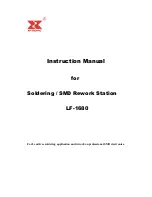
10
EN
digital soldering station PSIS 10-230V
Soldering wires together
•
Use a wire stripper to remove the cable jacket.
•
Twist the thin cable wires with each other, then add some
solder by gently heating the cable end with the soldering
iron. Due to the capillary effect, the molten solder is
sucked into the twisted cable end.
•
If available, use a soldering aid (helping hand) for aligning
the cables next to each other.
•
Using the soldering tip, heat both aligned cable ends and
add further solder. Soldering has been successful once
both wire ends are covered by a joint solder tin coat.
Soldering boards
•
Prepare the elements to be soldered by bending the
connection wires according to the holes of the breadboard.
•
Insert the connection wires into the board whilst slightly
bending the wires to ensure that the components are being
kept in the right position.
•
Heat the solder pad and the connection wire with the
soldering iron, then add some solder to the heated solder
joint.
•
Make sure that the molten solder entirely covers the solder
pad and surrounds the connection wire completely.
Switching the device on
Wear your personal protective equipment when working with
the device.
Note
Make sure that there is a soldering tip in the soldering iron.
Never heat the soldering iron without a soldering tip!
Note
Always use the soldering iron holder for the intervals while
heating the soldering iron, for breaks between the work steps
and while the soldering iron is cooling down (
4
).
1. Place the soldering iron (
9
) in the soldering iron holder (
4
).
9
4
2. Set the on/off switch (
1
) to position "I".
1
ð
The last preset temperature (default setting 300 °C) is
indicated on the display (
16
) for 3 seconds. Afterwards,
the display indicates the current temperature.























